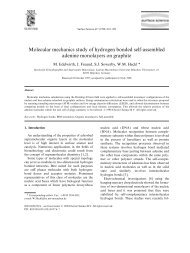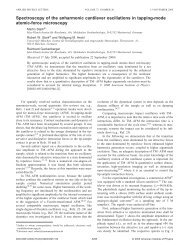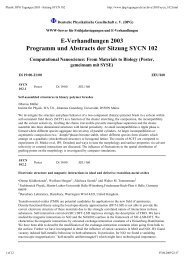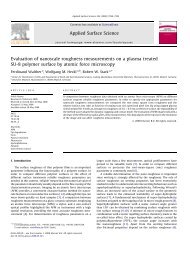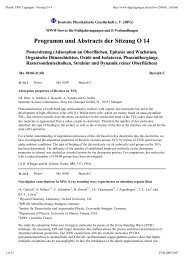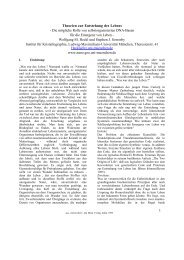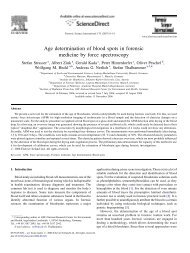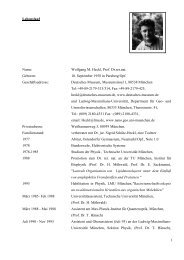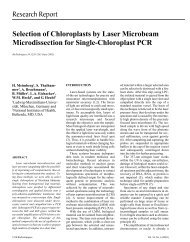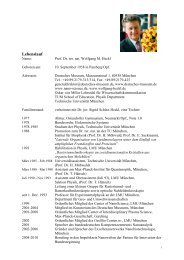Physik: DPG Tagungen - Sitzung O 28 - Nano-science.de
Physik: DPG Tagungen - Sitzung O 28 - Nano-science.de
Physik: DPG Tagungen - Sitzung O 28 - Nano-science.de
You also want an ePaper? Increase the reach of your titles
YUMPU automatically turns print PDFs into web optimized ePapers that Google loves.
<strong>Physik</strong>: <strong>DPG</strong> <strong>Tagungen</strong> - <strong>Sitzung</strong> O <strong>28</strong><br />
http://www.dpg-tagungen.<strong>de</strong>/archive/2004/o_<strong>28</strong>.html<br />
Institut für <strong>Physik</strong>alische und Theoretische Chemie, Universität Bonn, 53115 Bonn<br />
Mit <strong>de</strong>m Ziel kleine, organische Moleküle als "Son<strong>de</strong>n" auf die Oberflächenreaktivität elektrokatalytisch aktiver,<br />
binärer Elektro<strong>de</strong>n einzusetzen, wer<strong>de</strong>n potentielle organische Säuren zunächst auf <strong>de</strong>n Oberflächen <strong>de</strong>r<br />
einzelnen Metallkomponenten untersucht.<br />
Dazu wur<strong>de</strong> das Reaktionsverhalten von Ameisensäure (HCOOH) bei Kontakt mit einer Pd(111)-Elektro<strong>de</strong> im<br />
UHV mittels TDS, UPS und IRRAS sowie in Lösung mit IRRAS untersucht.<br />
Die spektroskopische Charakterisierung <strong>de</strong>r chemisorbierten HCOOH im UHV zeigt die Desorption <strong>de</strong>s intakten<br />
Moleküls aus <strong>de</strong>r Multilage bei 160 K und in geringen Mengen aus <strong>de</strong>r Monolage bei 186 K. In <strong>de</strong>r Monolage<br />
überwiegt <strong>de</strong>r Zerfall zu CO 2 und H 2 . Zahlreiche Intermediate <strong>de</strong>s katalytischen Zerfalls können anhand ihrer<br />
IR-Absorptionsfrequenzen zwischen 1800 cm -1 und 1900 cm -1 nachgewiesen wer<strong>de</strong>n.<br />
In situ IR-Untersuchungen in reiner HCOOH zeigen sowohl die katalytische Freisetzung von CO 2 als auch die<br />
beschleunigte elektrochemische Oxidation ( > 0.4 V vs. NHE) <strong>de</strong>r Säure.<br />
O <strong>28</strong>.19 Poster Mi 16:00 Bereich C<br />
Ab-Initio-Investigation of Static and Magnetic Properties of Fe|GaAs(001)<br />
•Harald Dobler und Dieter Strauch<br />
Institut für Theoretische <strong>Physik</strong>, Universität Regensburg, 93040 Regensburg<br />
We <strong>de</strong>termine the structure and magnetic properties of the (001)-surface of GaAs covered by iron. Encouraged<br />
by our former investigations of the system Fe|ZnSe, where we have obtained dramatic <strong>de</strong>viations from the i<strong>de</strong>al<br />
structure as well as sensitivity of the magnetic properties to structural changes, we consi<strong>de</strong>r another example<br />
for the compound semiconductor. Again, the lattice constant of GaAs and the doubled value of α-Fe agree very<br />
well. Nevertheless, we find significant variations of the i<strong>de</strong>al behavior. We present our results for one, two,<br />
three, and four monolayers of iron. Similar to the case of Fe|ZnSe the effects are most interesting for a single<br />
monolayer. Therefore, we show the structures and the profiles of the <strong>de</strong>nsity of valence electrons and the<br />
magnetization in the direction perpendicular to the interface.<br />
The computations are carried out in the framework of spin polarized <strong>de</strong>nsity functional theory implemented in<br />
the program package VASP [1,2]. Further, we use expansion in plane waves, ultrasoft pseudopotentials, and<br />
generalized gradient corrections (GGA). The relaxations of the structures are realized using a conjugate-gradient<br />
method.<br />
[1] G. Kresse and J. Hafner, Phys. Rev. B 47, 558 (1993)<br />
[2] G. Kresse and J. Furthmüller, Phys. Rev. B 54, 11169 (1996)<br />
O <strong>28</strong>.20 Poster Mi 16:00 Bereich C<br />
Si(001) surface optical properties modified by organic functionalization and oxidation<br />
•Andreas Hermann, Frank Groth, Wolf G. Schmidt, Kaori Seino, Martin Preuss, Patrick H. Hahn und Friedhelm<br />
Bechstedt<br />
Institut für Festkörpertheorie und Theoretische Optik, Friedrich-Schiller-Universität, Max-Wien-Platz 1, 07743<br />
Jena, Germany<br />
Tremendous efforts have been <strong>de</strong>voted to investigate the optical properties of clean Si(001) surfaces. Their<br />
reflectance anisotropy spectra (RAS) are now well un<strong>de</strong>rstood in terms of <strong>de</strong>fects and transitions between<br />
surface states as well as surface-modified bulk wave functions [1]. Far less is known about the modifications<br />
of the surface optical response by chemical reactions. Inspired by recent experiments [2] we study numerically<br />
the influence of organic functionalization with phenanthrenequinone and layer-by-layer oxidation on the RAS<br />
spectrum of Si(001). The calculations are performed using the gradient-corrected <strong>de</strong>nsity functional theory<br />
(DFT-GGA) in conjunction with non-normconserving ultrasoft pseudopotentials and a plane-wave basis. The<br />
7 of 32 07.06.2009 22:14



